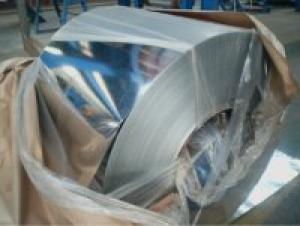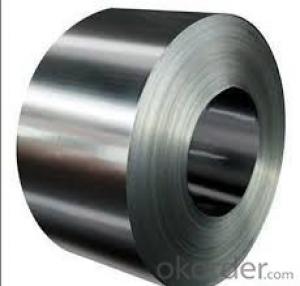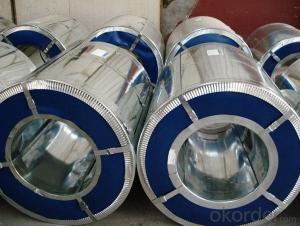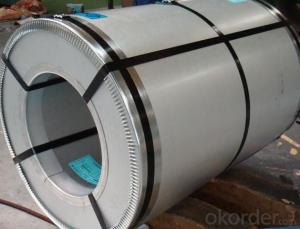Gavanized steel coil
- Loading Port:
- China Main Port
- Payment Terms:
- TT OR LC
- Min Order Qty:
- -
- Supply Capability:
- -
OKorder Service Pledge
Quality Product, Order Online Tracking, Timely Delivery
OKorder Financial Service
Credit Rating, Credit Services, Credit Purchasing
You Might Also Like
Packaging & Delivery
| Packaging Detail: | Export standard package :bundled wooden box or be required; The inner size of container is below: 20 ft GP:5.8m(length)x 2.13m(width)x 2.18m(high) about 24-26 CBM 40 ft GP:11.8m(length)x 2.13m(width)x 2.72m(high)about 68 CBM We will packing as the factory ,and reach the stander of export . Or as the customer request.In addition,We will make the products with good surface protection. |
| Delivery Detail: | 3-10days after receving the deposite |
Specifications
gavanized steel coil
1) cold rolled steel plate
2) SUCC ,DC01 ,SPCC.
3) Standard GB13237 Q/ ASB 334
- Q:I am using mild steel wire (very thin and bendable) for an art project, and would like to know if using a soldering torch is effective enough to get the job done. Or do I have to use a butane torch to heat the metal?BTW, is it better to use soft or hard solder?
- You can indeed by using the correct flux as normal soldering fluxes as used by plumbers will not work. I believe to solder steel it requires an acid flux which will corrode copper so when its done make sure its well cleaned afterwards and if possible apply a corrosion proofer afterwards ie paint or even petroleum jelly. I am curious as to why you would want to solder wire to a steel nail.
- Q:How are steel coils tested for compliance with industry standards?
- To ensure compliance with industry standards, steel coils undergo a series of rigorous quality control measures. These tests are conducted to verify that the coils meet necessary specifications and are suitable for various applications. Among the primary tests performed on steel coils is dimensional inspection. This entails measuring the thickness, width, and length of the coils to ensure they fall within specified tolerances. Any deviations from the required dimensions may indicate manufacturing defects or potential issues during fabrication. Another crucial test is visual inspection, where trained inspectors meticulously examine the coils for surface defects like scratches, dents, or cracks. Identifying and rectifying these defects is essential as they can impact the performance and durability of the steel coils before they are supplied to customers. Additionally, mechanical properties testing is carried out to assess the strength, elasticity, and toughness of the steel coils. This includes conducting tests for tensile strength, yield strength, and elongation measurements. These evaluations help determine if the coils are suitable for specific applications and if they meet the required performance standards. Furthermore, chemical composition analysis is performed to validate the elemental composition of the steel coils. This analysis is crucial as it ensures that the steel meets the required chemical requirements, including the presence of specific alloying elements. Deviations in composition can significantly affect the overall quality and performance of the coils. Corrosion resistance testing is also of great importance, particularly for coils used in environments with high humidity or exposure to corrosive substances. Coils are subjected to simulated real-world conditions, such as salt spray or humidity chambers, to evaluate their resistance to corrosion. Lastly, various non-destructive testing techniques, including ultrasonic testing and magnetic particle inspection, are employed to detect internal defects or discontinuities in the steel coils. These tests assist in identifying any hidden flaws that could compromise the structural integrity of the coils. In summary, steel coils undergo a comprehensive array of tests to ensure adherence to industry standards. By conducting these tests, manufacturers can guarantee that the coils meet the required specifications, thereby providing customers with high-quality products tailored to their specific needs.
- Q:What are the different methods of steel coil surface cleaning?
- Some of the different methods of steel coil surface cleaning include pickling, shot blasting, and chemical cleaning. Pickling involves immersing the steel coil in an acid solution to remove oxides and scales. Shot blasting uses high-speed particles to remove rust, scale, and paint from the surface. Chemical cleaning involves using specialty chemicals to dissolve contaminants and restore the steel coil's surface.
- Q:How are steel coils inspected for coil set?
- Steel coils are inspected for coil set by uncoiling a portion of the coil and measuring the amount of curvature or shape deviation. This is done using specialized equipment and techniques to accurately assess and quantify the coil set present in the steel coils.
- Q:basically all the info you can find about s1 tool steel i found a bunch about annealing, and hardening, tinsel strength and stuff like that but i need MORE!!!!!
- s1 tool steels (also calles high-speed steels) are used in the manufacture of cutting tools such as drills, reamers, taps, milling cutters, and lathe cutting tools. They are made from different types of steels. They are generally used in machine shops for making holes. .
- Q:my step father bought a big steel drum grill it has steel sheets (very thin) that go inbetween the flame and the food (closer to the flame) with that there the food will not cook, it does not get hot enough????? please help... what should we do
- that steel plate there is to try to keep the grease dripping of the food from making the grill flame up and burning the food. most all quality grills have something similar. you can take the plate out but your going to be prone to flame ups.
- Q:I want to know where cold formed steel framing is used, is every steel frame we see in a construction sites like houses, building and bridges cold formed steel frames? or hot formed steel framing?I also read that cold formed steel framing is used for floors, is the steel frame beneath the floor's concrete cover?Thank u very much!!
- It will vary from location to location. A possible way of telling is how the material is joined. If the material is riveted together it is likely cold rolled. If the material is welded then its probably normalized steel (possibly annealed but less likely). Cold rolling increases the yield strength of the material so less of it is needed. However, it also make the material more brittle. Welding creates defects in the region surrounding the weld and these are more likely to grow and cause failure in a cold rolled steel than a normalised or annealed steels. In addition the heat from the welding will change the microstructure that was deliberately introduced by the cold rolling process resulting in a localised drop in yield strength. Normalised and annealed steels are more ductile and tougher than Cold rolled steel but they have a lower yield strength. Because they are tough and ductile they are less sensitive to crakcs and defects so welding won't lead to as big a reduction in strength. Another possible consideration is the environment they are used in. Steels exhibit a transition temperature (actually more like a range) where they go from behaving like a ductile material to a brittle material. A well known example of what this can cause are the Liberty ships in WW2 (Supply vessels from the US to the UK). These were made by welding together sheets of cold rolled steel to form one continuous Hull. Unfortuantely the transiton temperature of the steel taht was sued was around 4 degrees while the Baltic Ocean is about 0 degrees. As a result small cracks would grow and then when the reached a critical size they would tear through the ship at the speed of sound in the metal (1500m/s) and these massive cargo ships would literally snap like twigs. So, if the steel is being used somewhere really cold its unlikely to be Cold rolled too.
- Q:What are the different types of steel coil edge condition options?
- The different types of steel coil edge condition options include mill edge, slit edge, and deburred edge. Mill edge refers to the natural edge of the steel coil as it comes from the mill, which may have slight imperfections. Slit edge is created when the coil is cut into narrower widths, resulting in smooth edges. Deburred edge involves removing any sharp burrs or rough edges from the coil, providing a clean and safe edge for handling.
- Q:What are the common applications of steel coils in construction?
- Steel coils are commonly used in construction for various applications such as structural components, including beams, columns, and trusses. They are also used for roofing and cladding systems, as well as in the fabrication of reinforcing bars and precast concrete elements. Additionally, steel coils are utilized in the manufacturing of pipes, tubes, and sheet metal products, serving as a crucial material in the construction industry.
- Q:What is the process of galvanizing steel coils?
- Enhancing the durability and protecting steel coils from corrosion involves a series of steps in the galvanization process. To begin, the steel coils undergo a thorough cleaning to eliminate any dirt, oil, or impurities on the surface. This is achieved through an acid pickling process, where the coils are immersed in a diluted acid solution or treated with a chemical cleaner. The aim is to ensure the surface of the coils is free from contaminants, allowing for better adhesion of the zinc coating. Following the cleaning process, the coils are rinsed to remove any remaining acid or cleaner, preventing adverse reactions in the next stage. The subsequent step involves the actual galvanization, where the cleaned coils are submerged in a bath of molten zinc. To guarantee an even coating, the coils are carefully passed through the zinc bath using rollers or other mechanisms. The zinc bath is maintained at a specific temperature, typically around 450°C (842°F), enabling the molten zinc to bond with the steel surface. Upon withdrawal from the zinc bath, excess zinc is eliminated by passing the coils through air knives or by centrifugal spinning. This ensures control over the thickness of the zinc coating, resulting in a uniform appearance. Once the galvanization process is complete, the steel coils are gradually cooled to room temperature. This facilitates the solidification and firm bonding of the zinc coating with the steel surface, creating a protective barrier against corrosion. The final step involves inspection and quality control. The galvanized steel coils are carefully examined for any defects, such as uneven coating or areas with insufficient zinc coverage. This inspection is typically conducted visually or using specialized equipment capable of detecting anomalies. Additionally, the coating thickness is measured to ensure it meets the required specifications. In conclusion, the galvanization process for steel coils is designed to enhance their longevity and shield them from rust and corrosion. By applying a layer of zinc coating to the steel surface, the coils become more resistant to environmental factors, making them suitable for a wide range of applications across various industries.
1. Manufacturer Overview |
|
|---|---|
| Location | |
| Year Established | |
| Annual Output Value | |
| Main Markets | |
| Company Certifications | |
2. Manufacturer Certificates |
|
|---|---|
| a) Certification Name | |
| Range | |
| Reference | |
| Validity Period | |
3. Manufacturer Capability |
|
|---|---|
| a)Trade Capacity | |
| Nearest Port | |
| Export Percentage | |
| No.of Employees in Trade Department | |
| Language Spoken: | |
| b)Factory Information | |
| Factory Size: | |
| No. of Production Lines | |
| Contract Manufacturing | |
| Product Price Range | |
Send your message to us
Gavanized steel coil
- Loading Port:
- China Main Port
- Payment Terms:
- TT OR LC
- Min Order Qty:
- -
- Supply Capability:
- -
OKorder Service Pledge
Quality Product, Order Online Tracking, Timely Delivery
OKorder Financial Service
Credit Rating, Credit Services, Credit Purchasing
Similar products
New products
Hot products
Hot Searches
Related keywords






























